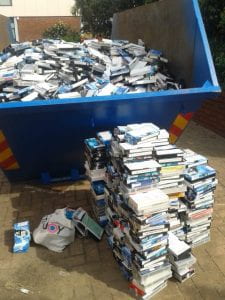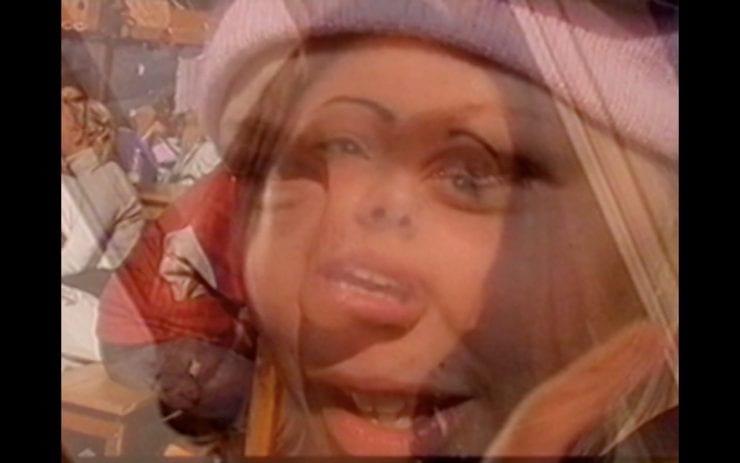Katie Hare is a London based artist whose narrative practice exists across video, performance and text; using personal memories of popular culture and historic events Hare’s work poses questions to our use and understanding of media and technology. A chance encounter with a skip full of VHS tapes, that were being deaccessioned by Goldsmiths University library, lead to the making of Skip (2015), a film that traces Hare’s attempt to discover more about a girl in a tv documentary she had seen a decade earlier.
Katie Hare Skip (2015) Digital video, colour, sound, 7.48mins
From a conversation with Hare:
In Skip I’m trying to position the viewer in the mind of the narrator, with these glimpses of disconnected images/memories/information flashing up, that you’re trying to process in order to construct some kind of story or logic. I guess that is where “I” and the personal aspect come into the work – it’s not a video about what happened to the girl in the story but rather about what happened when I became interested in trying to find out about her through following this fragment of a memory. It was a happy accident that the story ended up taking this kind of ridiculous, fortuitous route with the skip…
I need to give full credit to my friend, the artist Carl Gent, who was working in the library and alerted me to the fact that the video library was being thrown out. I was studying at Goldsmiths at the time and was working in my studio in the Laurie Groves Baths and raced round the corner to the skip expecting to find loads of people going through it but (shocker!) there was no-one there. I started taking the videos out of the skip, checking them and then stacking them on the ground (see picture) and then some point I realised that I needed to climb in if I wanted to look properly. I remember I started finding tapes from the same year as the video I was looking for and having this realisation that maybe I might actually find it and then as the hour was nearly up there it was! It was amazing. I took it home along with about 15-20 other tapes I’d picked up on a variety of issues including football hooliganism, menstruation, teenage witches, crack addiction and the political history of tap dance.

I am interested in the specific experience of people of my generation (older millennial/Gen Y) who’ve grown up with the internet and digital technology but not to the degree that Gen Z or younger generations have or will do, where they’ve been introduced to this stuff from birth– so there’s still this kind of sense of a before and after, which has fuelled my interest in the blurry lines between the past and future.
I think the current dominance of streaming has given us a false sense of security. We have the impression that we have access to everything at our fingertips but if Spotify went down no-one would have a record collection anymore… I think the “experience of culture” is important too, why this story stuck with me, what it says about that time and the time we’re in now.
When I was digitising the stuff from the skip, I was shocked at how misogynistic adverts were in 2002, even though I’d lived through that period of time. It’s kind of like the reassessment that’s going on at the moment of Britney’s breakdown and the way Jade Goody was treated by the tabloids, where there’s this mass realisation there was this really messed up culture at a time that a lot of the liberal media likes to present as these kind of pre-Brexit New Labour sensible Halcyon days. I guess I am trying to say that going back and examining these moments is important to resist flattening things out and retain complexity.
When discussing this stuff, I have sometimes come across a perception held by some that to take an interest in obsolete technology is inherently fetishistic or some kind of resistance to “progress.” One thing I always come back to is the quote in the catalogue to The Inoperative Community exhibition at Raven Row, which stated that all the 16mm films in the exhibition were being shown digitally to avoid “fetishizing film projection”, which seemed really weird to me. How is it fetishizing something to show it in the media it was created in? You’re literally changing the materiality of the work in order to avoid “fetishizing”, which is fascinating and bizarre. I think we can have a much more interesting conversation about this stuff which goes beyond nostalgia and sentimentality, and look at the shifting relationship to materiality, artefact and commodity that occur as a result of the rapid evolution of technology and obsolescence.
Bio
Katie Hare lives and works in London. Working largely in video, but also across performance, sound and text, her work examines the effects of the increasing rapidity of technological progress, particularly with regards to memory and obsolescence and the way narrative and storytelling is shifting as a result of this development. Recent exhibitions and screenings include False Memory ( Rugby Art Gallery and Museum, Rugby, 2020), Its origins are indeterminate (Whitechapel Gallery, London, 2018), Repeats (Figures and Infrastructures)(SixtyEight Art Institute, Copenhagen, 2018) and Sustain Your Errors! (with Cicely Farrer) (Centrespace, Visual Arts Research Centre, Dundee, 2018)
Visit her website here


Published by